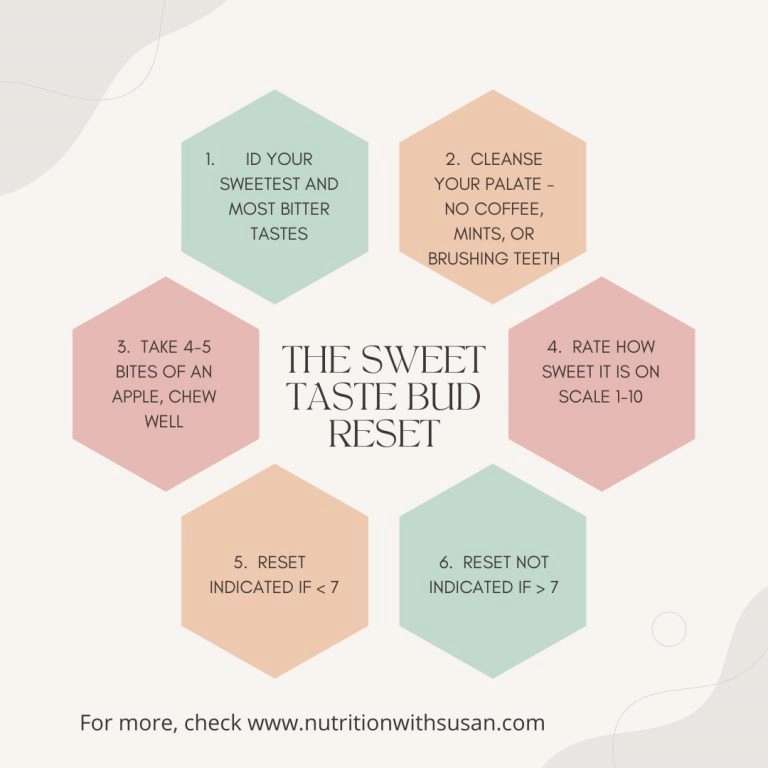INTRODUCTION: DO YOU NEED A SWEET TASTE BUD RESET
If you are what you eat, are you super sweet? Do you crave sugar and have to have something sweet every single day? Are your sweet taste buds currently in overdrive? Maybe it’s time for a sweet taste bud reset!
What things can trigger your sweet cravings? Well, things like:
- Fatigue
- Poor nights sleep
- Frustration
- Excess salt intake
- Stress
The WHO (world health organization) advises that healthy adults should limit their intake of added sugar to six teaspoons daily. Yikes, that’s not much — how many spoonfuls do you get in most days? If it’s more than what’s recommended, you may benefit from a sweet taste bud reset.
However, bear in mind that this reset is not a replacement for your healthcare practitioner’s advice specific to you. Its purpose is to provide you with general educational information to help reveal what’s putting your taste buds in hyperdrive and show you ways to reduce and remove any contributing factors.
HOW TO DO A TASTE BUD RESET:

- Identify a sweet scale – what is the sweetest thing you remember tasting? That’s your #10. What is the ‘I had to hold my nose and swallow it tasted so bad’ or something super bitter that you recall tasting. Make it your #1.
- Clean your palate with water or cucumber slices etc. (not with coffee, mints, or brushing teeth).
- Take 4-5 bites of an apple, and chew well.
- Immediately answer ”How sweet is this” (Scale of 1-10).
- Reset indicated if your number was <7. For the next 7-10 days follow the plan below to help reset your taste buds. Repeat the reset test after 7-10 days to see if your taste buds got better.
- •Reset not indicated if >7.
*Don’t forget to pay extra attention to things that may trigger your sweet cravings when doing your reset.
TASTE BUDS SAY NO TO:

ADDED SUGARS
Too much added sugar can make it harder for your immune system to work its best.
When it comes to added sugar, most of us can consume some, especially from better sources, but when we overdo it our body doesn’t run better. Too much sugar contributes to so many issues including digestive, sleep, skin, energy, aging, anxiety and depression, performance, getting sick, and how quickly you recover which may increase the risk of chronic disease.
If you have skin issues and/or digestive complaints and/or are struggling to lose weight around your middle you’ll likely see benefits from reducing your added sugar intake.
NON-NUTRITIVE SWEETENERS
Non-nutritive sweeteners can replace some added sugar to reduce calories and sugar intake. Because many are much sweeter than sugar, using a little can meet sweetness goals.
Non-nutritive sweeteners mean they lack nutrients, so if you are going to use them, ideally use them in conjunction with a nutritive food or supplement to maximize your overall micronutrient intake
However, when we swap the sugar for non-nutritive sweeteners, problems can arise too. Non-nutritive sweeteners may trigger dialed-up sweet cravings (most of these sweeteners are 100s to 1000s of times sweeter than sugar or fruit), reduced sense of feeling full (satiety) which can lead to consuming more and may impact our gut health.
The “less is better” philosophy for sweeteners can apply to everyone. However, we are all in different stages of our personal health journeys so what’s better varies from person to person. Always check with your healthcare practitioner to develop a personalized plan for your needs.
SUGAR IN YOUR SUPPLEMENTS
Avoid artificial colors, sweeteners, and chemical isolates as supplements, they won’t help your body run better. For example, gummies taste great but do often contain added sugar which may not be accurately reflected on their label. If you make organic and non-GMO food choices, do the same for your supplements.
If you identified your supplements as part of your total added sugar intake, discuss with your practitioner if there are better options or if you want to keep those supplements, and what else needs to be adjusted.
TASTE BUDS SAY YES TO:

READING FOOD LABELS
Sugar isn’t always listed as “sugar” – it can also be called corn sweetener, corn syrup solids, crystal dextrose, evaporated cane juice, fructose sweetener, high-fructose corn syrup, galactose, malt syrup, galactose, glucitol, hexitol, inversol, isomalt, maltodextrin, malted barley, sorbitol, sucanat and zylose – and many others!
Could you spread your sugar intake better throughout your day? Now that you know where sugar hides and how much a better serving is, try to divide your added sugar intake better throughout your day. This helps support better blood sugar and can help reduce cravings.
ANY FRUITS, VEGETABLES, OR SPICES
Saying yes to fruits, veggies, and spices is a good thing.
Say yes to fruits and vegetables in all forms such as:
- Juices/ Smoothies
- Dried/Dehydrated
- Frozen/Ready-to-Eat/Canned
- Baked/Air-fryer/Roasted/Sauteed etc.
- Desserts/Sweet treats from these
Get creative and think about ways you can add more of these to your diet. Can you buy the unsweetened or plain version of something and add fruit or bake starchy vegetables or add less of a sweetener than what’s in the package?
ALKALINE FORMERS
Sugar and artificial sweeteners are highly acidic which is one reason sugar is linked to so many health problems. That’s why it’s important to eat plenty of alkaline formers every day. The key to alkaline-forming foods is to understand that it’s about balance. It’s not necessary to cut out all acidic foods. Alkaline formers should build the foundation of your daily intake and be used to offset when you enjoy acid-forming foods and beverages.
The number one alkaline-forming food is water. Your body uses water to flush out toxins and deliver nutrients to your cells but also to restore and maintain healthy pH throughout your digestive tract.
Green is the color of alkalinity. The list includes watery green vegetables (cucumbers, celery, green beans, broccoli), dark leafies (kale, collard greens, spinach, chlorophyll, grasses (wheat, barley), green fruits like (kiwi, limes, avocado, olives), and sea vegetables (algae, seaweed).
But also topping the list are lemons, mushrooms, beets, watermelon, coconut, radishes, grapefruit, herbs, and many herbal teas. Other alkaline formers include plant protein sources like nuts and seeds, beans especially almonds, hemp, sesame seeds, navy, and lima beans.
CONCLUSION:
Better nutrition gives your body what it needs to run better while avoiding what can irritate, overwhelm and disrupt those efforts. That means the more quality nutrients you pack into each bite and sip, the more your body gets what it needs. It also means what each person needs more today will be different. That’s what makes personalized nutrition so much better for you. What did your sweet taste bud reset reveal to you?
Please leave a comment and let me know! If you want to dive a little deeper into how sugar can affect your immune system, you’ll want to sign up for my upcoming “Too Hot To Handle” course in January which focuses on different factors that can have a huge impact on your body’s inflammatory response.
Stay tuned, it’s coming soon!

